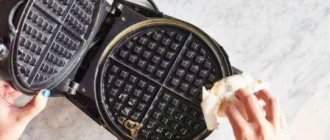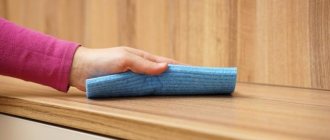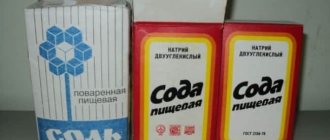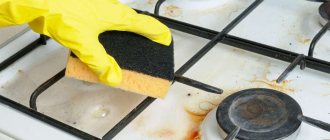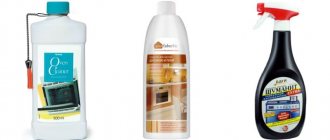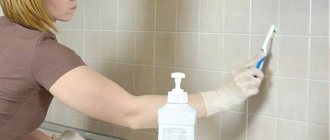Modern deep fryers use removable Teflon-coated bowls. Along with these, many housewives also have old deep fryers - the bowl in them cannot be removed, and it is not so easy to wash it. Let's look at both options. After using the deep fryer, hot oil and grease accumulate on the walls, which requires cleaning. This process is quite labor-intensive, since cleaning a fryer from old oil at home is a tedious and dirty job. Cleaning should be done as needed.
If the deep fryer is used at home only occasionally, then it will not be difficult to wash it of old oil if you clean it after each use.
If you use this equipment frequently, it is enough to change the oil regularly and clean it thoroughly after a few days. Otherwise, the fat on the inside surface of the fryer turns into a dark coating that is difficult to remove.
Cleaning process for a deep fryer with a removable bowl
Many manufacturers produce electrical appliances in which the lid and inner bowl are removable. This makes the cleaning process much easier.
The electrical appliance should not be washed under a water tap or in a dishwasher, so as not to cause a short circuit and further damage to the appliance.
Before cleaning the fryer, unplug it and wait until it cools completely, as hot oil can cause serious burns. Water getting into a container with hot fat is especially dangerous.
Deep fryer with removable Teflon bowl.
After the fryer has finished operating, you must wait until the inner container has completely cooled down and remove the bowl. If there are burnt food residues in the bowl, under no circumstances scrub them with a hard brush or knife - you will ruin the Teflon. How to clean a deep fryer:
- Wipe the inside of the deep fryer bowl with a damp cloth to remove any burnt-on frying residue. Remove stuck fragments with a silicone scraper. Caution is required as vigorous movements may damage the non-stick surface of the fryer.
- To easily wash off burnt oil, fill the bowl with hot water, add a drop of dishwashing gel and leave to stand for several hours.
- Instead of dish gel, you can pour 2 tablespoons of 9% vinegar into the bowl. After this time, wash the bowl with soapy water.
- The resulting limescale deposits on the walls of the fryer bowl can be easily washed by wiping its surface with a sponge soaked in a 5% vinegar solution, and then removing any remaining scale with a paper towel.
Used oil can be reused by draining it into a separate container with a lid and storing it in the refrigerator. If you want to dispose of used fat, it should be placed in a sealed container and thrown into the trash. Under no circumstances should oily waste be poured down the drain, as this will clog the drain pipes. The food basket, removed from the appliance, is washed in the sink. You should first moisten it with water, wipe it with a sponge with a few drops of dishwashing detergent and leave it for a while to dry.
Recommendations
To successfully clean the fryer from old oil and not damage the non-removable bowl, you need to remember several rules:
- Do not use metal sponges, scrapers or hard brushes for cleaning. They will damage the non-stick coating, and as a result, grease will accumulate in the cracks after each use of the device.
- The deep fryer can only be cleaned with gel products or liquid solutions. Powders cannot be used; they also scratch the coating of a fixed or removable bowl.
It is strictly forbidden to try to wash the unit with technical solvents, gasoline, acids and other toxic substances. The old fat will disappear without a trace, but the device will be unsuitable for food use.
Cleaning a deep fryer with a fixed bowl
If you have a deep fryer with a bowl that cannot be removed, then you need to wash it a little differently.
- First, drain all the fat from the container, then wipe off the remaining fat with a paper towel or an unnecessary rag. A sponge will not help here, as it will only smear the oil. Wiping begins from the bottom, then the walls are cleaned in a circular motion.
- After this, you should pour heated water from a kettle or tap into it, add a drop of dishwashing gel and wait.
- After 30 minutes, you can proceed to the next cleaning step. The water must be heated directly in the deep fryer by connecting the device to the mains. If severe contamination is present, the water is boiled for several minutes.
- Drain the water and wipe the fryer container dry with a paper towel or rag.
- If there are traces of oil left, pour water into a bowl, add 1-2 tablespoons of vinegar and boil for 5 minutes. Then drain the water and dry the bowl.
- Old grease will be removed from the walls of the deep fryer by boiling water with grated laundry soap. Boil for 15-20 minutes.
- Another way to get rid of baked-on grease is to combine baking soda and vinegar and pour the fizz into a fryer with water and bring to a boil.
A deep fryer in which the bowl cannot be removed.
After unplugging, the fryer basket can be dipped in and out of hot water several times. To make it easier to wash, you can additionally add detergent to the water. Use a kitchen brush to wipe away an old stain of dried grease from the basket. After this, it should be held under a tap with running water to wash it from the soapy solution, wipe it dry with a towel or dry it in a dryer for clean dishes.
How to clean different types of filters?
In addition to caring for the bowl, heating element, and outer surface of the device, cleaning the filters is also very important. Filters are usually located in the lid of the device. They are removable, non-removable, foam rubber, carbon. The type of filter can be found in the instructions for use. Often it will also tell you how to clean it properly.
Removable carbon filter
Foam filters are the easiest to clean. To clean such a filter, you need to remove it from the device cover, wash it with detergent and leave it to dry for a couple of hours. This type is extremely convenient as it does not require additional costs.
Removable carbon filter
Carbon filters fight unpleasant odors. They retain the smell within themselves. This type is not intended for cleaning and washing; the old filter must be disposed of and purchased a new one. This filter lasts for quite a long time (35 preparations) and the price of a new one is low.
The methods described above are suitable for removable filters. If the filter is not removable, then under no circumstances should the lid be dipped into a soapy solution or under running water. You need to do the following:
- Wipe the filter with a damp cloth,
- Wipe with a cloth and detergent,
- Wash off the detergent from the filter with a clean cloth.
- Wipe the filter dry.
You can also buy oil filters. This filter is convenient to use so as not to change the oil very often. It helps to strain out the old oil, since after several uses it may have an unpleasant smell and taste.
Cleaning Industrial Fryers
Industrial appliances can be washed using special kitchen brushes with soft bristles and a long handle. If deep fryers are used frequently in restaurants, the oil should be filtered 1 or 2 times a day. As soon as the oil develops an unpleasant bitter odor when heated, it should be replaced completely.
After draining the oil, the internal surfaces must be cleaned of food residues. Cleaning the outside and edges of the deep fryer not only improves its appearance, but also increases its service life. Apply detergent to such surfaces for a few minutes before washing, and then wipe off with a damp cloth after 10 minutes.
Once every six months, a deep fryer used for industrial purposes is cleaned by boiling. Boil the water collected in the frying container for at least 20 minutes with the addition of a special detergent. After washing and rinsing, you need to pour water and vinegar into the oil container, which will help completely remove soap residue.
Depending on the model of fryer you use, cleaning methods may vary. Therefore, before cleaning the deep fryer, you should read the instructions supplied with the appliance.
Excessively soiled
This phenomenon occurs when the vessel sits with oil for a very long time or its replacement occurs untimely. But even in this case, you can clean the deep fryer from frozen fat - you just need to take more “serious” measures.
- The use of special sponges will greatly help the housewife solve this problem, although it should be noted that they are very expensive and most often disposable. There are special porous sponges for washing delicate surfaces, washcloths soaked in various detergents, microfiber sponges and others - the choice is up to the housewife. First, you need to wash the dish with the usual means indicated above, and only then use a special washcloth. Note: after using a sponge soaked in special products, you should thoroughly clean the deep fryer from any residues of these substances, since they are usually aggressive chemicals.
- If the case is very advanced and no method can cope with dirt and grease, then you can soak the bowl with stove cleaning products, after washing the deep fryer in the usual way. At the same time, leave the substance on the walls of the vessel for no more than 3 hours, otherwise it may corrode the surface coating of the deep fryer. In this case, you need to work in a draft, wearing gloves and, if possible, a protective mask.
And finally, it should be noted that such troubles can be avoided by timely cleaning and changing the oil in the deep fryer.
Please rate the article:
Join on Telegram
Tips for Air Fryers with a Metal Bowl
These tips are not suitable for Teflon bowls!
- Burnt oil stains that cannot be washed off with liquid detergent can be cleaned with a damp sponge sprinkled with baking soda.
- Abrasive detergents are used only as a last resort. After this treatment, thoroughly rinse the fryer parts to completely remove any remaining chemicals. After rinsing the bowl, you should fill it again with water and run your hand along the bottom and walls in order to determine the quality of washing. If traces of a fatty film are visible on the surface of the water, then you should pour 50 grams of vinegar into it.
- Make sure the fryer is completely dry before using it again. Accessible parts can be wiped with a towel; the remaining elements should be dried naturally.
- Do not wash an electrical appliance that is plugged in.
- Do not completely immerse the fryer in water.
- If the bowl is made of stainless steel, then simply wash it with hot water, using a soft sponge and any detergent.
Important points
Before starting the cleaning procedure, it is necessary to clarify some points related to contraindications:
- First, you should stop using extremely hard brushes and metal sponges. Equally, these dishwashing items are contraindicated not only for deep fryers, but also for other cooking utensils that have a non-stick coating. While hard cleaning devices are quite suitable for cleaning a cast-iron frying pan or cauldron, they are not suitable for more delicate kitchen appliances. As a result of their use, the formation of scratches and cracks is inevitable, which will lead to their filling with oil and regular burning.
- The folk wisdom of cleaning “everything and everything” with soda or powder with abrasive particles is not relevant in this case and is even harmful. Such methods of treating a contaminated surface will most likely lead to damage and damage to the bowl.
- Scrapers, sandpaper and other means of rough cleaning of the deep fryer are not permitted.
When it is clear and understandable what products should never be used when cleaning the deep fryer, you can begin to describe the process itself.
Since deep fryers differ in their design features - removable or non-removable bowl - the methods for cleaning them are somewhat different from each other.
Cleaning by type of contamination
There are different degrees of contamination, which require different cleaning approaches. There are three levels of contamination: light, medium and old grease.
Lung
Light contamination will form if the oil has been left in the bowl for a day or more. Standard dish soap can handle this level of contamination.
To remove grease, fill the bowl with hot water and add a small amount of detergent. We do this two or three times, usually this amount is enough to thoroughly clean the container. After this, three containers until clean.
Average
With such contamination, thickened oil is formed. To remove it you will have to perform additional manipulations. If you cannot remove the oil using the standard method, then you should resort to other methods:
- Take hot water (about 80 degrees);
- Pour water into the bowl, adding several tablespoons of acetic or citric acid. If necessary, repeat the procedure.
- At the end of the procedure, rinse the container thoroughly with running water.
- It is better not to leave it to air dry, but to wipe it with a dry towel.
Another effective way to wash the bowl is to use the most common laundry soap.
Old fat
Old grease appears if you do not wash the fryer for a long time. Fat is no longer so easy to clean and you will have to use a special cleaning tool, such as sponges or brushes (designed for non-stick surfaces). After using the methods described above, carefully clean the equipment with special brushes.
How to clean a deep fryer at home
- Disconnect the device from the power supply and allow the oil to cool, then drain it into a container for storage or dispose of it if it is no longer suitable for further use.
- Place the basket in the sink and use a sponge to apply detergent to it. Leave the basket in the sink and give the detergent time to work on the grease.
- During this time, use a plastic scraper to remove any grease from the surface of the bowl.
- Fill the bowl to the top level with water, adding grease-fighting detergent. Stir until the product is completely dissolved in water.
- Plug in the device and wait for the water to boil, then leave the boiling process for a few minutes. During this time, the remaining oil will move away from the walls. Meanwhile, use a brush to clean the grate in the sink.
- Turn off the electric fryer and let the water cool completely. If there is any traces of grease on the grate, place it in the bowl.
- Drain the water and scrub the sides of the bowl with a dish sponge, trying to remove any softened fat residue from the inside of the fryer.
- Rinse the bowl under water.
If there is still an oily film on the walls, then the next step is to use baking soda. Mix baking soda with water to form a paste and apply it to the entire surface and rub in with a cloth. The baking soda paste will help remove grease and is so fine and soft that it will not scratch the surface of the bowl. After cleaning the bowl, treat the entire body of the fryer with this paste; soda will easily remove traces of oil splashes and from the plastic.
- Thoroughly rinse the baking soda and grease remover off the entire appliance, then dry it with a towel. If moisture remains in some hard-to-reach places, give it time to completely evaporate before starting to use the device.
Washing the fixed bowl
The main condition is to prevent moisture from getting inside the case, so the napkins or sponges should be slightly damp.
Algorithm of actions:
- make sure the oil is cold and the plug is unplugged;
- remove any remaining oil using paper towels;
- apply a little gel to the sponge, lightly foam it, treat the container from the inside;
- Wipe the treated surface with a damp cloth 3-4 times, rinsing it each time;
- wipe the bowl dry;
- leave the container open for 1–2 hours to completely evaporate the moisture.
When cleaning the deep fryer, do not use metal sponges, sharp objects, or abrasive cleaners.
To the point! Secrets of cleaning a multicooker inside and out
Safety precautions
Before cleaning the device, make sure that it is disconnected from the power supply and that the oil has cooled to a temperature not exceeding 35 degrees.
Before cleaning, make sure there is no oil left in the container.
If you plan to use it further, pour it into a glass jar carefully so as not to drip onto the heating element. When working with aggressive cleaning agents, use rubber gloves.
Washing heating element and filters
After use, you need to clean not only the inner surface, but also the heating element and filters. To do this, carefully remove the parts of the device and wipe them with paper towels. Then try to wash the parts with a soap solution.
If an electrical appliance has a carbon-based filter, it should be periodically replaced with a new one. In other cases, washing and drying is sufficient.
Some housewives suggest that getting rid of old fat is much more difficult. In such situations, you can resort to baking soda and vinegar. Therefore, it is better to wash off all the fat at once, then the device will work correctly and delight you for a long time.
A deep fryer is a multifunctional household appliance. It is used to prepare potato fried dishes. The popularity of this device is constantly growing and every year more and more housewives are purchasing this device.
Like any equipment, a deep fryer requires some care. If it is used quite often, then the user should know how to properly wash and clean it. The thing is that poor cleaning will lead to the formation of plaque, which is difficult to get rid of.
To clean the device you will need dishwashing detergent, a paper towel, a sponge, heated water, and salt.
